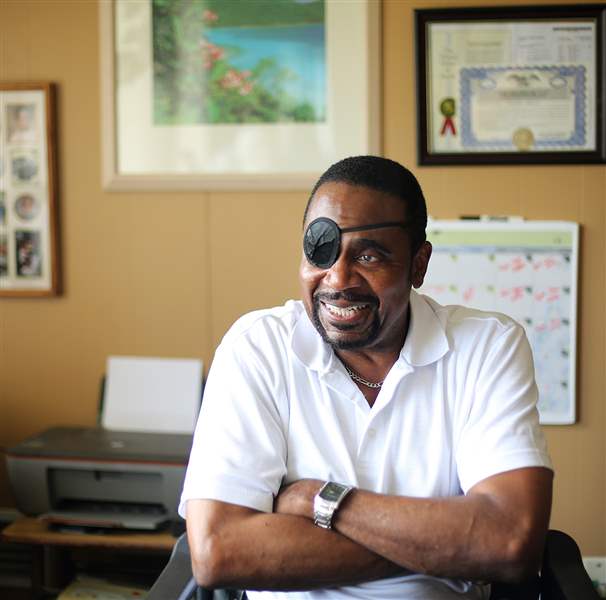
OTTAWA HILLS INVENTOR OPTIMISTIC
Caps marketed to scale down concussions
7/24/2014
Ron Roberts, a former University of Toledo football player, has patented a skullcap that uses a thin, waffle-shaped gel liner to absorb and disperse the shock that comes from a blow to the head.
THE BLADE/JEREMY WADSWORTH
Buy This Image

Ron Roberts, a former University of Toledo football player, has patented a skullcap that uses a thin, waffle-shaped gel liner to absorb and disperse the shock that comes from a blow to the head.
A former University of Toledo football player has developed a product that he believes can reduce concussions in contact sports, though he’s finding it hard to get his product into the market.
Ron Roberts, who lives in Ottawa Hills, has patented a protective skullcap that uses a thin, waffle-shaped gel liner to absorb and disperse the shock that comes from a blow to the head. The caps, which look like normal skullcaps many football players already wear, are meant to be worn under a standard football helmet or other helmet.
“We’re not saying this is the end-all, be-all as far as concussions go,” Mr. Roberts said in a recent interview. “What we say is it reduces the frequency and severity of concussive forces, and our data proves that.”
Mr. Roberts’ company, Thundawear LLC, tested the cap at ICS Laboratories in Brunswick, Ohio, one of the nation’s leading testing facilities for sporting goods. He said their results found that his cap, when worn under a helmet, lowered the severity index, and head injury criterion, and reduced g-forces.
An official with ICS confirmed that Mr. Roberts’ caps were tested there, but said the lab couldn’t discuss clients, their marketing claims, or test data.
A member of the defense on UT’s undefeated 1969, 1970, and 1971 teams, Mr. Roberts said he never suffered a concussion in his playing days. However, he became increasingly interested in the topic as his own son began playing and media attention focused on prominent NFL players’ injuries.
“A lot of careers were ending,” he said.

Tim Ross models Ron Roberts’ skullcap that is marketed to reduce head injuries.
A concussion is essentially an injury to the brain that comes not from the initial impact, but from the impact of the brain moving within the skull.
Dr. Patrick Siparsky, a sports medicine specialist at the University of Toledo Medical Center, the former Medical College of Ohio, said much of the recent focus on concussions has come out of research that found former NFL players suffered damage that lasted long beyond their playing days.
Dr. Siparsky isn’t familiar with the work Mr. Roberts has done but said numerous products have tried to address the issue with varying levels of success. One reason it seems so difficult to address, he said, is that all concussions are a little different.
“It’s very complicated,” Dr. Siparsky said. “It’s not just how hard, it’s how hard, what direction, what position was the rest of the body in.”
Some of the best advances to date, the doctor said, have been in how physicians deal with patients who have been concussed. Primarily that means more rest, and more understanding that no two people will heal the same way.
The impetus for Mr. Roberts’ invention — the only thing he has ever invented — came when he read something about how gels were being used to disperse impacts.
He spent several years working to prove that his product would work, including a partnership with a University of Toledo Engineering class that rigged up an accelerometer and did drop tests to gather data.
Later, after testing was complete at ICS and prototypes were finalized, Mr. Roberts said he met with several prominent athletic goods companies including Nike Inc. and Under Armour Inc., trying to secure a licensing deal. A northeast Ohio investor interested in setting up a company specifically to market the skullcap even went so far as drawing up a contract, but Mr. Roberts said financing fell through and the deal fell apart.
He also felt he was near a deal with Under Armour, but said they pulled back after the NFL’s $765 million settlement in 2013 to dispose of a lawsuit brought by thousands of former players.
Shortly after news of that came out, the league announced it was working with Under Armour and General Electric on an open innovation challenge for ways to protect the brain from traumatic injury.
“We were almost there,” Mr. Roberts said. “We had it right in our fingertips and we could almost taste it. But it didn’t happen.”
To that point, Thundawear had put all its efforts into finding a licensing partner. Now, Mr. Roberts wants to take the product directly to market. He said he has deals in place with fabric providers and local sewing contractors, but he needs more money to move forward.
Mr. Roberts and his investors, who are largely family and friends, have already put about $150,000 into the project.
“We know we’ve got something that can make a difference,” he said.
Contact Tyrel Linkhorn at tlinkhorn@theblade.com or 419-724-6134 or on Twitter @BladeAutoWriter.